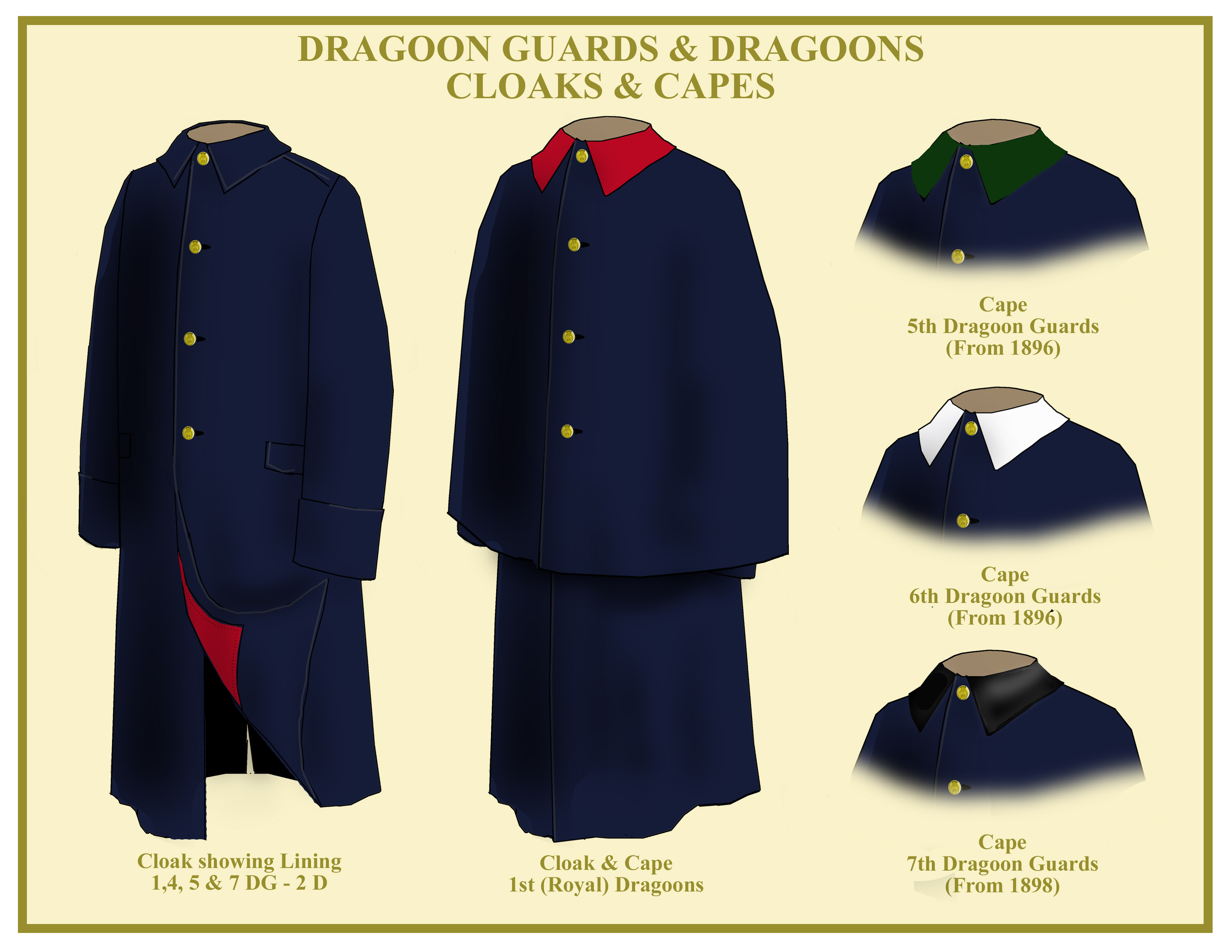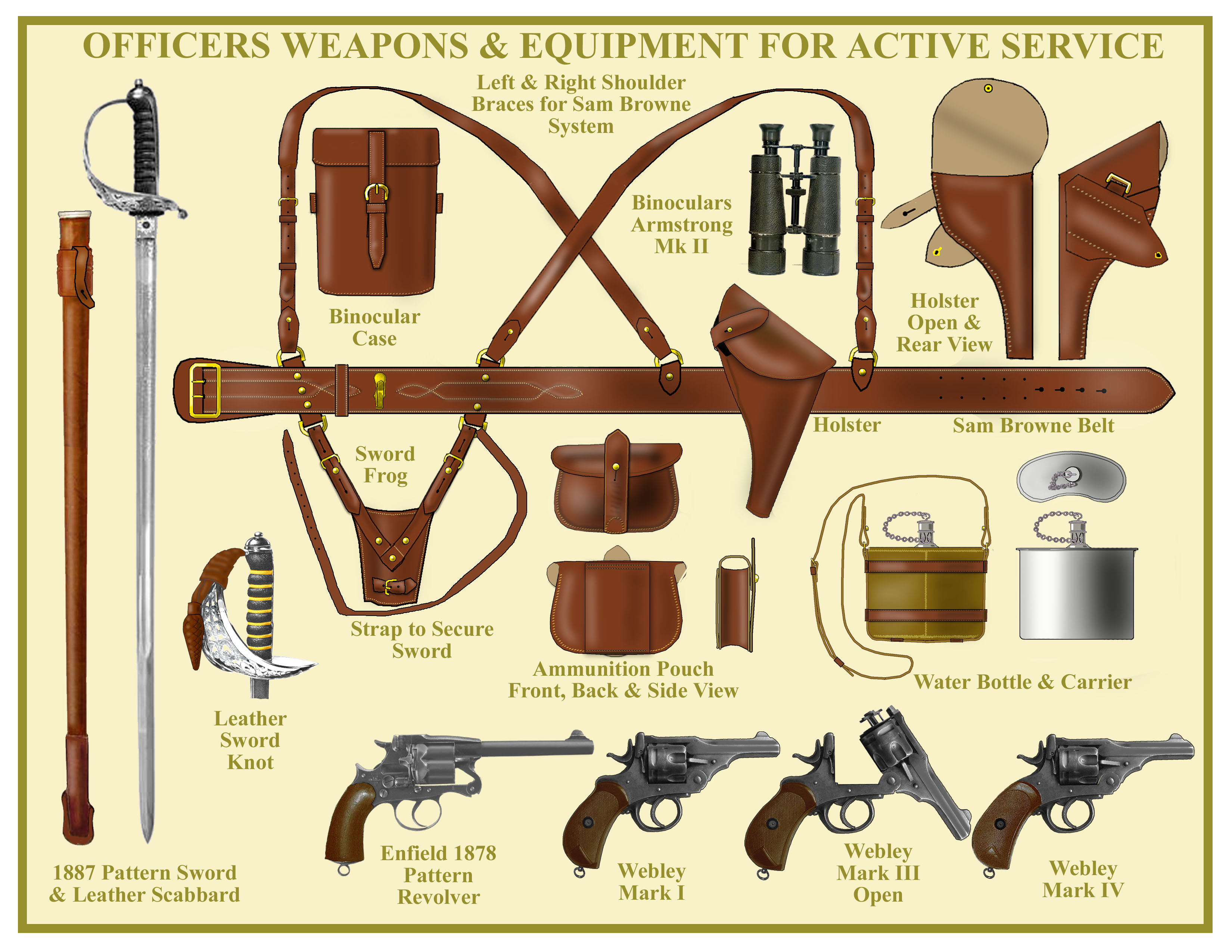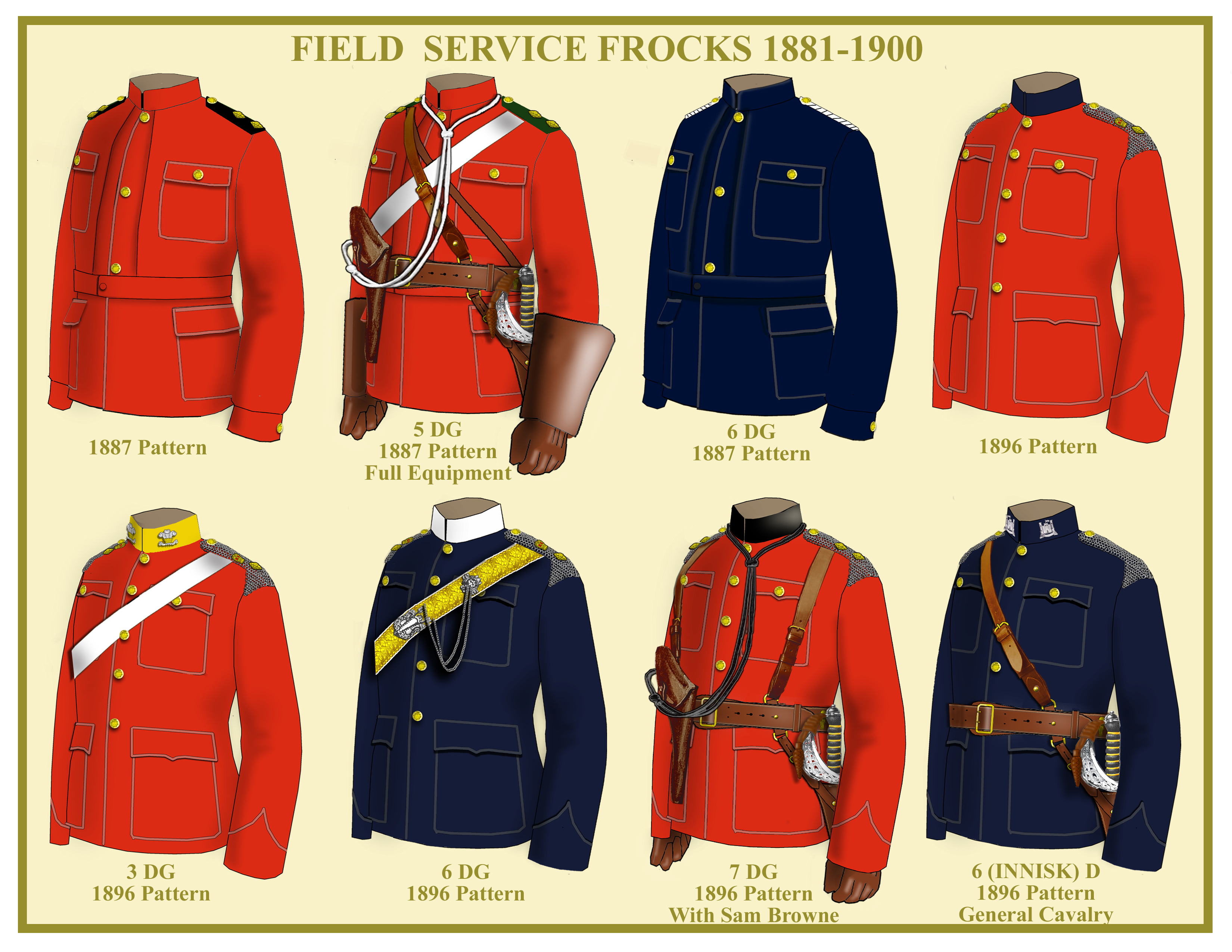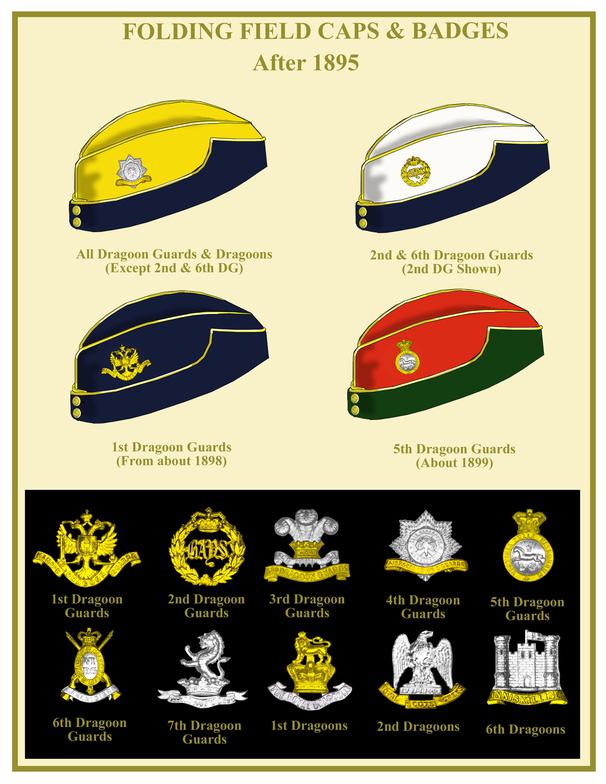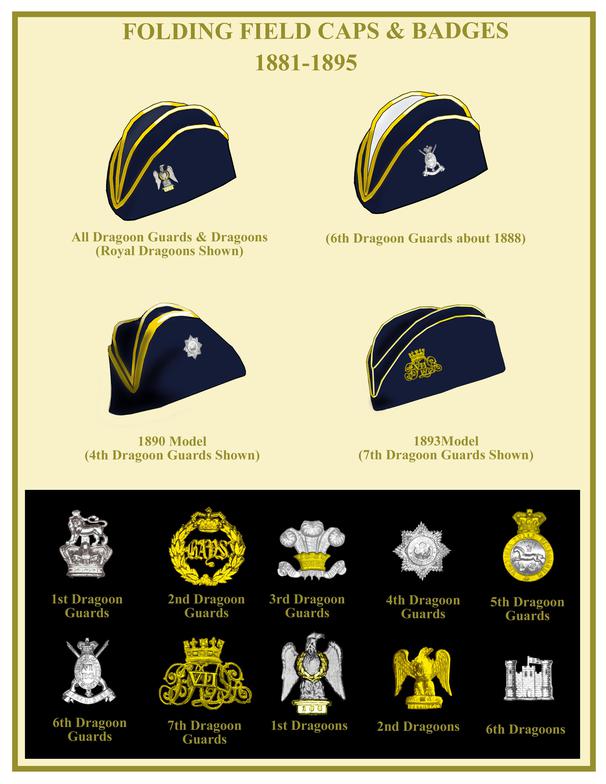HEAVY CAVALRY UNIFORMS, ARMS & EQUIPMENT - DRAGOON GUARDS & DRAGOONS
FIELD SERVICE UNIFORMS
EQUIPMENT, WEAPONS, CLOAKS & CAPES
The concept of field service dress for operations on European soil had not been given much attention in the years after the Crimean War. As it was, most of the British Army’s campaigning had been going on in the Empire and troops had rapidly adapted to conditions with clothing that was more conducive to colonial warfare. Following the experience of the Indian Mutiny, khaki and cotton uniforms were much more suitable in the hot climates prevailing in India and Africa. By the time of the 2nd Afghan War khaki was worn almost universally by troops in India although the Zulu war and the Egyptian campaign of 1882 still saw the army in scarlet, rifle green and blue. The last sight of a scarlet tunic in battle was at Ginnis, Sudan in 1885. The one item that had become universal by 1881 was the foreign (or tropical) service helmet in white or khaki (or with khaki cover) and worn with or without a spike.
When it came to field service uniforms in Europe, there was not much help from the great armies that fought in the Franco-Austrian War (1859), The Austro-Prussian War (1866) or the Franco-Prussian War (1870). They largely wore their parade uniforms with only a few adaptations for service. The Austrians and French wore heavy greatcoats (often without uniform jackets beneath) and the only concession the Prussian and other German armies made were knee boots with trousers tucked in. Soft undress caps were often worn and some shakos had oilskin covers.
So what would a British Army have worn if involved in a European campaign in the eighteen-eighties and nineties? Experiments with drab uniforms had been made in the mid-eighties with some infantry units being issued with them on a trial basis, but they were soon put back in store. There appear to have been no such measures with the cavalry. Clearly, because of their overseas experiences, the British army was ahead of Europe on campaign dress and one assumes that officers and other ranks would have worn undress frocks and perhaps the foreign service helmet which would have been more comfortable especially as the home service helmet was a hindrance when firing a rifle lying down. Certainly, the field service caps or glengarries that were introduced from the 1870s would have been worn extensively. One thing is sure is that the War Office did recognize that uniforms for “Active service and peace manoeuvres” were required and dress regulations reflected that. Ironically, the next large conflict that embroiled Britain was not in Europe but South Africa, where uniforms and equipment designed only for wear on campaign finally became understood.
FIELD SERVICE CAPS
As early as the Crimean War, the foot guards had adopted a flat folding field cap similar to that worn by the rank and file in the Austrian army which itself was an evolution of the ‘bonnet de police’. Other ranks in the Guards continued to wear this cap well into the 1890s as they never took the glengarry into wear. By the mid-1870s this type of cap became popular with British officers serving overseas and photographic evidence supports this where it seemed to be almost ubiquitous during the Afghan campaign of 1878-80. It was often called the “Torin” cap (named after the Irish officer who supposedly designed the British Army version). Although it was authorized for overseas use it did not appear in dress regulations until 1883. It is described as a cap for “Active service and peace manoeuvres” being of blue cloth, 5 inches high with flaps 4 inches high to be folded down when needed. Although dress regulations did not mention it, the wedge top became white in the 2nd and 6th Dragoon Guards. The top and flaps were edged with French gold braid welts as were the front and back seams. There appear to have been several versions of this cap, the most popular being the simple one shown it the first three examples. The fourth was one appearing in the early nineties.
It was also noted that a regimental badge could be worn on the left flap. Unhappily, there is not much documentary evidence for the kind of badge that was worn. The Royal Dragoons were given permission by Queen Victoria in 1880 to wear a silver eagle with gilt wreath over a gilt plinth bearing the number “105” on their side caps. Regiments such as the 2nd, 3rd, 4th, 5th and 6th Dragoon Guards along with the Royal Scots Greys and Inniskillings already had long established badges which were probably used while the 7th Dragoon Guards adopted a special badge incorporating the crowned cypher of the Princess Royal. The King’s Dragoon Guards seem to have adopted the Royal Crest in silver at the same time that it appeared on the helmet plate.
In 1896 a new cap was ordered to be worn by all branches of the army. Again it was inspired by an Austrian cap worn in their army, often with a leather peak. Dress regulations stated that the body should be 4 ½“ high and not more than 3 ¾“ wide across the top. There was a small cloth peak that could be folded up. The flaps, that could be folded down were fastened across the front with two small buttons (described as ‘gorget’ buttons). For Dragoon Guards and Dragoons, the body was yellow and the peak and flaps were blue except in the 2nd and 6th Dragoon Guards where the body was white. The crown and top of flaps were edged with gold French braid welts.
The badges worn were those authorized in 1896 and fully described and illustrated in the 1900 regulations. Apparently, the colour scheme of this cap did not go down well (except perhaps in the 3rd DG and 6th Dragoons) and regimental versions began to appear in the late nineties. A cap with both blue body and flaps was adopted by the 1st and 4th Dragoon Guards quite quickly while other regiments took up their own colour schemes, the most striking being that of the 5th Dragoon Guards which had a scarlet body with dark green flaps, which according to the regimental history was being worn by officers in 1899. The 7th Dragoon Guards were said to have had a cap with black body. In most cases, photographs show, the front peak seems to have disappeared. A black patent leather chinstrap could be attached when mounted. This cap, in most cases, disappeared after 1902 and was replaced by the peaked forage cap in both a dress version and a khaki one. It would make its appearance again in 1938 in plain khaki and soon after in a kaleidoscope of regimental colours and remains in use today as a privately purchased alternative barrack cap for officers.
FIELD SERVICE FROCKS
A field service serge frock had been in use by infantry officers since the mid 1870s and had been worn extensively on overseas service as well as at home. No official serge frock for cavalry officers would appear in dress regulations until 1891. Photos, Illustrations and tailors drawings often show or describe serge jackets that could be worn by officers and they did wear modified other ranks frocks when on service abroad. The serge frock described in the 1891 regulations was first authorised in 1885 and for Dragoon Guards and Dragoons the frock was scarlet serge (blue in the 6th DG) of loose fit with pleats on each side of the front and five in the waist at the back. Two patch pockets were above and below the waist. There were three buttons down the front and the built in cloth belt was secured by a cloth covered button at the waist and one on each wristband.. The shoulder straps were of regimental facing colour (the 6th Dragoon Guards had white shoulder cords). The equipment worn with this dress would have included the Sam Browne belt system with haversack, water bottle with pistol holster and sword. (See Illustration 2nd from left below) Brown leather gauntlets were issued but not often worn.
In 1896 a new frock was authorised with shoulder chains (as worn by Indian Army officers since the mutiny) and collar the colour of the facings while the frock was the same colour as the full dress tunic. There were five buttons down the front and on each top pocket flap. This frock replaced the patrol jacket and was worn with various equipment including undress pouch belts and full dress pouch belts (See 6th Dragoon Guards who were not authorised to wear the undress pouch belt. Why is not known). The Sam Browne system with two braces (Figure bottom row 3rd from left) was seldom worn in this way by cavalry. The universal blue serge frock was also introduced at the same time with the same features as the scarlet one. All these frocks were worn with either the pillbox cap or the folding field cap but never with the full dress helmet. The blue frock is shown here with the Sam Browne system as worn by most cavalry officers ever since. This frock has evolved almost unchanged to become the No. 2 Dress Tunic for Cavalry Regiments in the British Army to this day.
OFFICERS EQUIPMENT AND WEAPONS
The sword suspension system invented by General Sir Samuel Browne after losing his left arm during the Indian Mutiny had already become the standard campaign equipment for officers of the army long before 1881. Photographs and illustrations show plenty of examples of it being worn in India and Afghanistan. It was worn by staff and colonial contingents during the Zulu War but not by many of the infantry officers just out from England. There is even a photo of it being worn by all the Naval officers in a Gatling gun contingent. The illustration below shows it in all its manifestations. The two-braces variant was apparently designed in 1878 by Lieutenant Sir Basil Templer Graham-Montgomery in India. It is the probably the most ubiquitous piece of officers equipment that has ever been worn. Even today it is standard for officers and senior NCOs in countless countries.
By 1895, standard binoculars and cases were authorized along with officers pattern water bottles and carriers. Officers carried their standard heavy cavalry sword on service, although many purchased one especially for that purpose. The sword knot was the same style as the dress one only in brown leather.
The revolver had been the firearm of choice for officers since the Crimean War. The models carried between that time and the period covered here were numerous and of varied efficiency. The names are familiar including Colt, Adams, Tranter and Beaumont-Adams. In 1881 officers were still carrying the unpopular Enfield service revolver introduced in 1878, and many purchased their own privately. Webley had been manufacturing firearms since the 1830s but only came to prominence when they supplied the Royal Irish Constabulary with 1000 revolvers in the early 1870s. They competed unsuccessfully to provide handguns to the British Government for many years until 1887 when their hinge-framed Mk I was chosen with the first batch going initially to the Royal Navy. The Mark I was followed by the Mark II in 1894. The 1897 Mark III was short lived and by the time of the Boer War, the Mark IV was available with features that would be standard in the forces revolvers for many years. From that time, Webley would become the primary pistol supplier to the British Armed services for over seventy years.The revolver had been the firearm of choice for officers since the Crimean War. The models carried between that time and the period covered here were numerous and of varied efficiency. The names are familiar including Colt, Adams, Tranter and Beaumont-Adams. In 1881 officers were still carrying the unpopular Enfield service revolver introduced in 1878, and many purchased their own privately. Webley had been manufacturing firearms since the 1830s but only came to prominence when they supplied the Royal Irish Constabulary with 1000 revolvers in the early 1870s. They competed unsuccessfully to provide handguns to the British Government for many years until 1887 when their hinge-framed Mk I was chosen with the first batch going initially to the Royal Navy. The Mark I was followed by the Mark II in 1894. The 1897 Mark III was short lived and by the time of the Boer War, the Mark IV was available with features that would be standard in the forces revolvers for many years. From that time, Webley would become the primary pistol supplier to the British Armed services for over seventy years.
OFFFICER'S CLOAKS AND CAPES
Officers’ cloaks (greatcoats in the non-mounted branches) and capes were to be worn on all occasions from parades to campaigns. They were to be of the same material as the other ranks.
They were of dark blue cloth and, because they were meant to cover most of the body when mounted, should be long enough to be just above the ankles. The lining was red in all regiments except the 6th Dragoon Guards where it was white shalloon. The collar was blue for all regiments. The cape was also blue with collars of blue cloth except for the 6th Dragoon Guards whose collar was white. The 1883 and 1891 dress regulations were the same in their descriptions. Later, the Royal Dragoons were allowed scarlet collars and the 7th Dragoon Guards Black velvet collars which were mentioned in the 1896 and 1900 regulations. The history of the 5th Dragoon Guards states that they adopted dark green velvet collars to their capes in 1899



